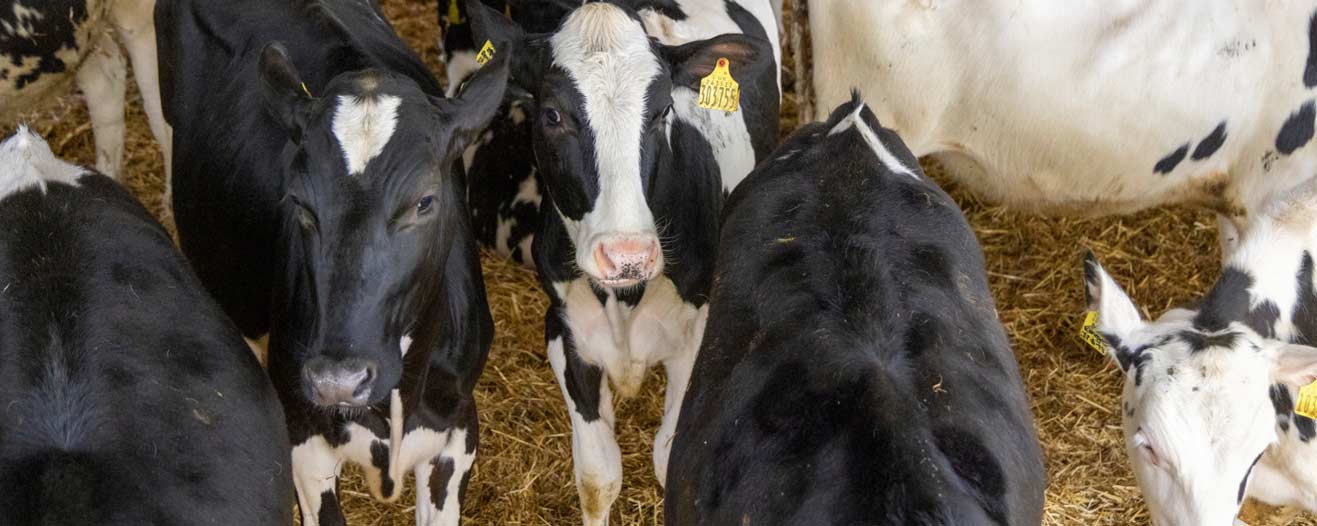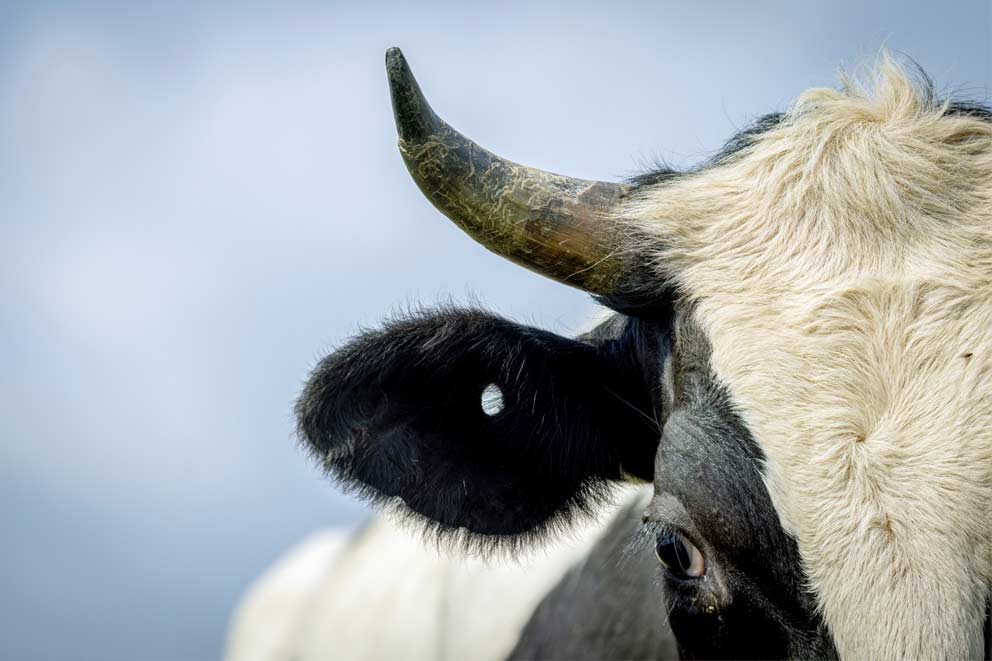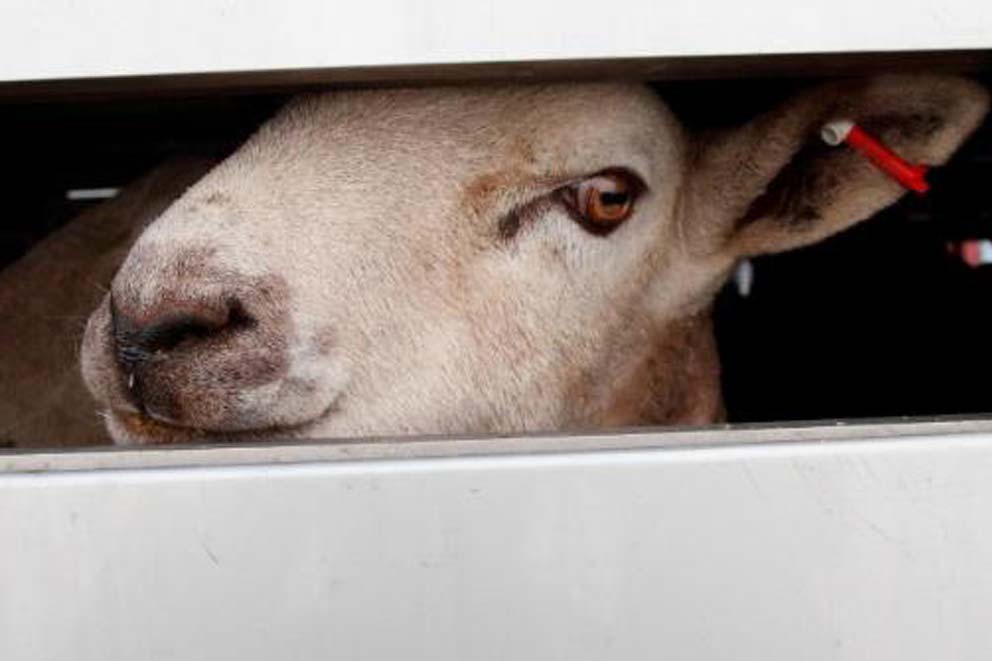Cattle behaviour and needs
Understanding the natural behaviour of dairy cows can help explain their needs.
- Cattle are very social animals and live in herds. Social hierarchies play an important role in herds, with some cows being more dominant than others. Cows also have preferred social partners in their groups, who they keep close to and are more likely to groom.
- Cattle are grazing animals and will feed on grasses and other plants that grow close to the ground. They tend to spend around one-third to one-half of their day grazing when kept in fields, eating more at dawn and dusk.
- The vegetation that cattle eat can be difficult to digest, so they've evolved a specialised digestive system to help them digest it. Their stomachs famously contain four chambers.
- Cows 'ruminate', which means they regurgitate, re-chew and then re-swallow partially digested food to further help digestion.
-
Cattle spend a large chunk of their day lying down. This is an important activity for cows as it's when they do most ruminating and when they rest and sleep.
Dairy cow farming
There are around 1.8 million dairy cows in the UK. While the number of UK dairy farms is going down, herds are getting bigger, so the overall number of dairy cows is staying fairly stable. The ways in which they’re farmed varies. Let's look at how dairy cows are most commonly kept.
Dairy cow life cycle
Cows are pregnant for nine months. Dairy farmers usually plan for their cows to give birth to their first calf when they're around two years old, so heifers (young female cows) will usually be pregnant for the first time when they're around 15 months old. After this, farmers generally aim for their cows to calve again every year.
Dairy cows produce milk for about 10 months after calving. The average UK dairy cow produces just over 8,000 litres of milk each year and has just under four milk producing cycles in her lifetime, which is typically six and a half years.
Dairy cow housing
In the UK, dairy cows are traditionally kept in fields in spring and summer when the grass is growing, and housed indoors during the winter. Around five percent of dairy farms keep their herds inside continuously, which is called a ‘continuous’ or ‘year-round’ housing system.
Two main types of dairy cow housing systems are used in the UK: cubicles and loose housing.
- Cubicles (or ‘free stalls’) – this is the most commonly seen housing system and consists of individual, bedded compartments where the cows can lie down. These usually have a concrete base, often covered with a cushioned rubber mat or mattress, which can be topped with bedding material such as sawdust, wood shavings or straw. Some cubicles are 'deep bedded', which means the concrete base is hollowed out and filled with a deep layer of bedding, most commonly sand. A house with cubicles will also contain areas where the cows can go to feed and drink and, sometimes, additional 'loafing areas' where they can go to congregate and socialise.
- Loose housing – this housing is very similar to cubicle housing, except the cows are given ‘deep-bedded’ yards to lie down in, instead of individual cubicles.
Feeding
Cattle housed indoors are usually given fresh feed once or twice a day in a trough or feeder. Some farms use ‘self-feed’ systems, where cows help themselves over the course of the day. Even when cattle are outside and grazing, they are often given additional feed.
Milking
UK dairy farms tend to milk their cows twice a day. This happens in the ‘milking parlour’. Cows may stand in two parallel rows, with the people milking them standing in a pit in the middle. Other farms have a ‘rotary’ system, which is circular and rotates, so cows enter in turn. ‘Robotic’ milking systems are automatic, with cows trained to enter a milking pen when they choose.
Dairy cow welfare issues
Here are some of our main concerns about the welfare of dairy cows across all farming systems.
Lameness
Lameness is widely regarded as one of the most urgent welfare issues affecting dairy cows because it's painful and affects a large number of cows. The term describes an animal having poor walking ability. Although levels vary from farm to farm, research suggests that between one-quarter and one-third of UK dairy cows are lame.
Mastitis
Mastitis is a disease in which the cow's udder becomes inflamed and painful, usually as a result of a bacterial infection. It's one of the most common health problems affecting dairy cows.
Research suggests that over a year, there will be around 22-29 cases of mastitis for every 100 cows in a herd; although this disease is not always well-recorded.
Cow housing
The quality of the environment in which dairy cows are kept can have a big impact on their welfare. Lying comfort is very important, as cows need to lie down for prolonged periods to maintain their health and need a comfortable area in which to do so. There needs to be enough space for sub-dominant cows to avoid the dominant cows.
The provision of environmental enrichment,such as cow brushes for scratching and exploration, gives the cows opportunities for positive experiences.
We think cattle, as grazing animals, also need to have access to good quality pasture. Scientific evidence supports this view.
Cow and heifers before and after calving
Dairy cows and heifers are more at risk of a range of health problems during the 'transition' period, which is the weeks before and after calving. This is due to changes in their immune system and energy levels. They need highly specialised management to ensure their welfare during this physically demanding time, with a particular focus on minimising stress, maximising cow comfort, and good nutrition.
Improving the lives of dairy cows
We're working in many different ways to give dairy cattle a better quality of life.
Developing welfare standards for dairy cows
We encourage dairy producers to follow our Welfare Standards for Dairy Cattle, which set out how we believe dairy cows should be managed and cared for in order to keep them healthy and happy. These are detailed welfare standards based on scientific evidence and practical farming experience. They are regularly updated to reflect the latest research and knowledge and are used by the RSPCA Assured scheme, and many other organisations, as a reference.
The RSPCA welfare standards cover every aspect of the animals' lives, including feed and water, environment, management, health care, transport and humane slaughter/killing. They're designed to ensure that all animals managed following the standards have their welfare needs met and a good life.
Advocacy work
We advocate for better dairy cow welfare through membership of a number of working groups and committees, and through discussions with government. For example, we're a member of the Ruminant Health and Welfare Group, which aims to prioritise, coordinate and assess the impact of national activities related to improving cattle health and welfare in Great Britain.
Research projects
We were a founding member of the AssureWel Project, alongside the Soil Association and the University of Bristol. The project (2010–2016) aimed to improve the welfare of farm animals, including dairy cows, by developing welfare outcome assessment protocols for use during farm assurance scheme assessments.
These protocols help farm assurance schemes better assess the level of animal welfare their members are achieving on their farms. It also gives them a way to measure how successfully their welfare standards are being put into use. Welfare outcome assessments are undertaken as part of RSPCA Assured farm assessments.
How you can improve the welfare of dairy cows
If more consumers insist on higher welfare products, more supermarkets will want to stock them. This will encourage more farmers to improve their farming practices and, ultimately, more farm animals will benefit.
Look for the RSPCA Assured logo
If you eat dairy products and you're concerned about dairy cow welfare, look for products carrying the RSPCA Assured logo. RSPCA Assured is a farm assurance and food labelling scheme that's dedicated to improving farm animal welfare. RSPCA Assured uses the RSPCA's strict animal welfare standards, which cover all stages of an animal's life from birth (or hatching) through to killing.
Visit RSPCA Assured to find information on where to buy RSPCA Assured labelled products and read all about their dairy cow standards.




